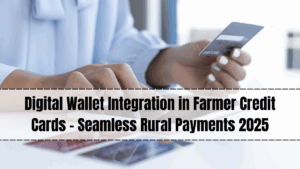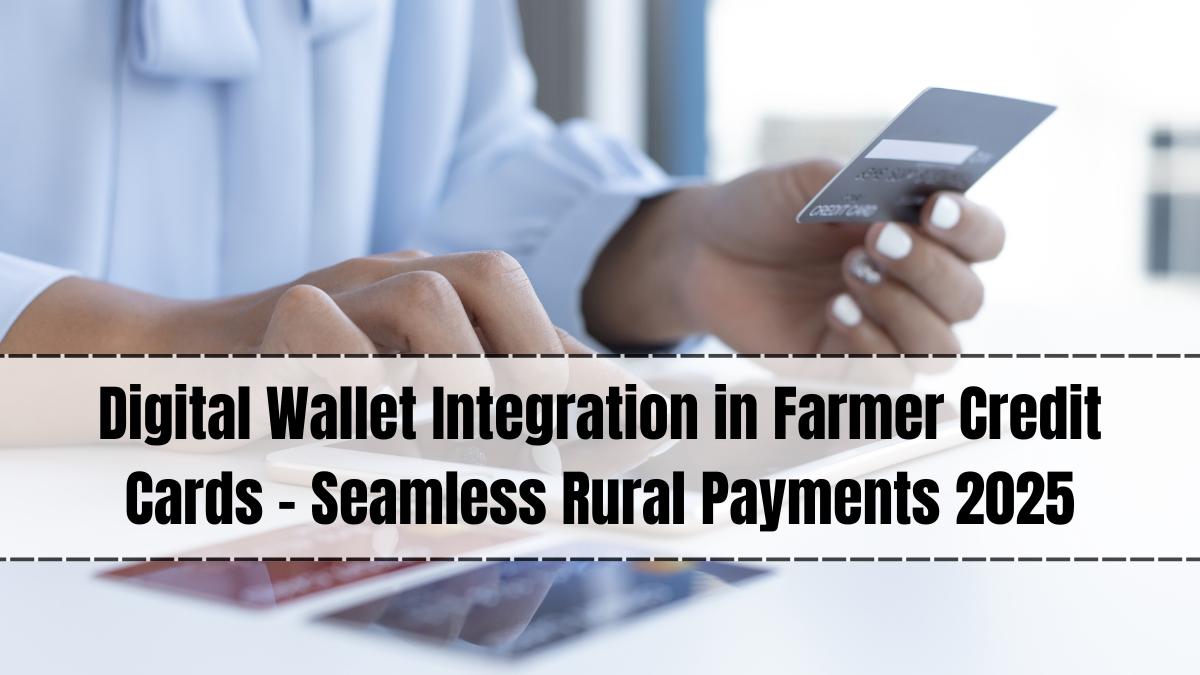In 2025, rural finance is undergoing a digital transformation that is making life easier for millions of farmers. One of the most impactful developments is the integration of digital wallets with farmer credit cards. Traditionally, farmer credit cards were used much like regular bank cards, primarily for purchasing agricultural inputs or withdrawing cash from ATMs. While they provided access to credit, the process was still tied to physical banking infrastructure, cash transactions, and limited merchant acceptance in rural areas. This meant farmers often had to travel long distances to find ATMs or approved vendors, wasting time and incurring extra costs.
The introduction of digital wallet integration has changed this scenario entirely. Now, farmer credit cards are linked directly to mobile-based digital wallets, enabling farmers to make payments instantly to vendors, service providers, or even other farmers, without handling cash. Whether it’s buying seeds from a local shop, paying for tractor rentals, or settling a bill for irrigation equipment, transactions can now be done with a simple tap on a smartphone. This integration is bridging the gap between traditional banking and modern fintech, giving rural communities the same convenience and speed that urban customers have enjoyed for years.
This innovation is more than just a payment upgrade—it is a game-changer in rural financial inclusion. Digital wallet integration ensures that funds from farmer credit cards can be used in both physical and online marketplaces. It reduces dependency on cash, improves transaction transparency, and enables easier tracking of spending, which in turn helps in financial planning and better repayment discipline.

The Limitations of Traditional Farmer Credit Cards
Farmer credit cards have been around for years, but their usage was limited by infrastructure and accessibility challenges. Many rural areas had few card-swiping machines, forcing farmers to withdraw cash for most purchases. Cash transactions often meant there was no record of how the funds were used, making it harder for banks to assess repayment capacity or offer tailored financial products. Additionally, carrying large sums of cash was risky, especially during busy seasons when input purchases peaked. Farmers also faced delays in payment settlements, particularly when dealing with suppliers in distant towns.
How Digital Wallet Integration Works
Digital wallet integration allows farmer credit cards to be linked directly to a mobile application. The farmer’s available credit balance is reflected in the wallet, and payments can be made by scanning a QR code, tapping an NFC-enabled device, or sending funds directly to another wallet or bank account. This means that even in small villages where there are no POS machines, farmers can still make cashless payments to local vendors who use a basic QR code setup.
The integration also supports instant payments for agricultural services such as drone crop surveys, machinery rentals, and advisory consultations. Farmers can pay directly from their wallet without worrying about finding exact cash or waiting for bank hours.
Benefits for Farmers
The most immediate benefit is convenience. Farmers no longer need to carry cash or travel to bank branches and ATMs. They can make purchases, transfer money, and even pay utility bills right from their phone. This saves time during critical farming periods like sowing or harvesting, when every day matters.
Another benefit is security. Digital transactions reduce the risk of theft or loss associated with carrying cash. The system also sends instant notifications for every transaction, allowing farmers to monitor their account in real-time. Moreover, transaction histories are stored digitally, providing proof of payment for disputes or warranty claims.
Digital wallets also make it easier for farmers to access online deals, bulk discounts, and e-commerce platforms for farm inputs, which were previously out of reach due to the lack of digital payment methods.
Advantages for Lenders and the Rural Economy
For banks and microfinance institutions, digital wallet integration means better tracking of credit utilization. They can see exactly how the loan or credit card balance is being spent, which helps in assessing repayment behavior and offering customized credit limits in the future. This transparency reduces the risk of loan defaults and enables the design of sector-specific financial products.
From an economic perspective, cashless transactions boost local businesses by speeding up payments and reducing cash handling costs. It also brings more rural vendors into the formal economy, enabling them to access loans and other financial services.
Integration with Government and Agri-Tech Initiatives
Digital wallet-enabled farmer credit cards can be linked to government subsidy systems, ensuring that subsidies for fertilizers, seeds, or electricity go directly into the farmer’s wallet. This eliminates leakages and delays in fund transfers. Additionally, when combined with other agri-tech tools like farm management apps or e-marketplaces, these wallets can become a central hub for managing farm operations, finances, and market connections.
Real-World Impact
In states like Karnataka and Rajasthan, pilot projects have shown a dramatic increase in credit card usage after wallet integration. Farmers who previously withdrew most of their credit as cash are now making over 70% of their transactions digitally. This shift not only improves convenience but also builds a credit history that can help farmers secure larger loans or better terms in the future.
The integration has also helped farmers during emergencies. For example, in flood-affected districts, relief funds could be transferred instantly to farmers’ wallets, allowing them to purchase essential supplies without waiting for physical aid distribution.
Challenges in Adoption
While the benefits are clear, adoption is still limited in areas with poor mobile connectivity or low smartphone penetration. Digital literacy remains a barrier, as some farmers are unfamiliar with using mobile payment apps. However, banks and government agencies are addressing this with training programs, on-ground support staff, and simplified wallet interfaces designed for first-time users.
FAQs
What is digital wallet integration in farmer credit cards?
It is the process of linking a farmer’s credit card to a mobile-based digital wallet for instant cashless payments.
How does it benefit farmers?
It saves time, reduces the need for cash, improves payment security, and allows access to online and offline marketplaces.
Can farmers without smartphones use this system?
In some cases, basic phones with USSD-based payment options can be used, but smartphone access provides full functionality.
Are digital wallet transactions secure?
Yes, they use encryption, OTP verification, and real-time monitoring to prevent fraud.
Is this system available across India?
It is expanding rapidly, with several banks and states already adopting it in 2025.
Click here to know more.
